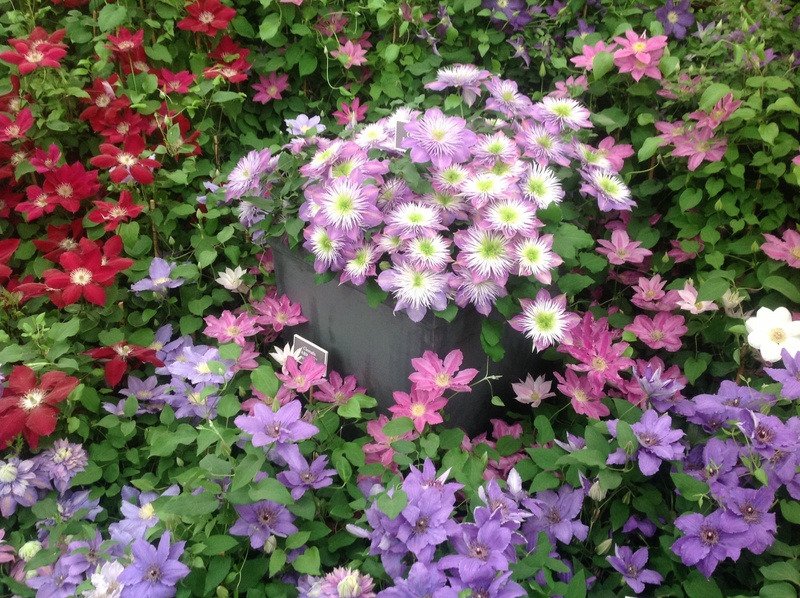Innovative Garden Designs Against Wind
Posted on 21/06/2025
Innovative Garden Designs Against Wind: Transform Your Outdoor Space
Creating a beautiful garden that thrives even in windy conditions is an exciting and rewarding challenge. Exposure to strong winds can damage plants, disrupt garden structure, and undermine your hard work. Fortunately, creative landscape design offers solutions to help you protect your garden and foster a lush, tranquil oasis. In this comprehensive guide, we explore innovative garden designs against wind--ideas and strategies that blend aesthetics, sustainability, and practical protection.

Understanding Wind and Its Impact on Gardens
Wind is a powerful force that can desiccate leaves, break stems, and erode soil. Before diving into innovative designs, it's crucial to understand how wind interacts with your garden. Consider these key effects:
- Physical Damage: High winds can snap branches, flatten flowers, or even uproot young plants.
- Increased Evaporation: Wind speeds up moisture loss from leaves and soil, making plants thirsty and stressed.
- Pollination & Pests: Wind-dispersed seeds may introduce weeds, or blow in pests.
- Microclimates: Wind exposure creates dry or cold areas, requiring specific plant choices.
With these factors in mind, innovative garden designs for windy sites focus on minimizing wind impact and creating a haven for your plants.
Principles of Wind-Resistant Garden Design
To develop an effective garden that stands up to the wind, apply these integral design principles:
- Deflect, don't block: Complete barriers often increase turbulence. Instead, use permeable windbreaks to filter and redirect gusts.
- Layering: Use a hierarchy of plants and features to slow the wind gradually, creating sheltered pockets.
- Right Plants, Right Place: Choose resilient plants and position them where they can best withstand wind pressure.
- Strategic Structures: Incorporate fences, screens, walls, and garden art for both form and function.
Innovative Windbreak Solutions
Living Windbreaks: Nature's Protective Barrier
Living windbreaks--rows or clusters of hardy trees, shrubs, and grasses--are among the most effective and visually appealing wind solutions. Unlike solid barriers, they filter the wind, reducing its speed while letting some pass through, thereby minimizing destructive turbulence.
- Evergreen Hedges: Plant robust species like yew, privet, or holly for year-round protection.
- Layered Shrubs: Combine different heights and densities. Place tall, deep-rooted species at the back, with bushier varieties in front.
- Native Grasses: Tall ornamental grasses like Miscanthus and Panicum create flexible, wind-filtering screens.
- Edible Windbreaks: Use berry bushes or fruit trees for utility and shelter (e.g., gooseberries or apple trees).
Living windbreaks are eco-friendly and enhance biodiversity, offering food and habitat for birds and pollinators. They evolve over time, becoming denser and more effective each year.
Architectural Screens & Fencing
Modern gardens often feature a combination of architectural elements and organic plantings. Consider these structures as part of your design:
- Slatted Fences: A fence with gaps--such as horizontal slats or woven panels--lets some wind pass through and reduces turbulence.
- Lattice Panels: Wooden or metal lattice screens covered with climbing plants double as support and living windbreaker.
- Breezeblock Walls: Decorative concrete blocks create wind-permeable boundaries with a striking mid-century look.
- Bamboo Screens: Sustainable, lightweight, and attractive, bamboo screens are perfect for contemporary and Asian-inspired gardens.
For best results, position screens at a distance of 1-2 times the height of the windbreak from your protected zone--the optimal range for wind reduction.
Earthworks and Level Changes
Topography offers natural wind protection. Take inspiration from these creative landscaping techniques:
- Berms: Raised earth mounds deflect and slow down wind. Shape berms gracefully for a natural look, and plant them with tough grasses or shrubs.
- Sunken Gardens: Lower planting beds and seating areas below ground level for inherent shelter.
- Gabion Walls: Wire baskets filled with stones provide rustic, permeable windbreaks that double as seating or borders.
Plant Selection: Choosing Wind-Resilient Species
When designing wind-resistant gardens, plant choice is paramount. Resilient species withstand strong gales, salt spray (if you're near the coast), and fluctuating conditions. Look for plants with:
- Flexible stems that bend rather than break (e.g., willows, dogwoods)
- Small, tough, or waxy leaves that resist drying
- Deep, robust root systems
- Dense growth habits for natural windbreaking
Popular wind-tolerant plants include:
- Elaeagnus
- Hawthorn (Crataegus)
- Sea Buckthorn (Hippophae rhamnoides)
- Pine and Spruce Trees
- Tamarisk
- Hebes
Include a mix of these in your innovative garden design against wind for endurance and year-round interest.
Creative Layouts for Windy Gardens
Zoning: Divide and Protect
Partitioning your garden into different zones can amplify wind resistance and enhance enjoyment. Try these zoning ideas:
- Protected Retreats: Use windbreaks, screens, and dense plantings to enclose seating or dining areas, giving you a cozy refuge.
- Wind-Tolerant Borders: Assign the windiest edges to tough, tolerant plants, while delicate species occupy sheltered interiors.
- Layered Approach: Create concentric rings of protection, with large trees or shrubs outside, mid-sized plants in the middle, and vulnerable varieties at the center.
Feature Walls and Art Installations
Functional features can double as art in innovative design for windy gardens:
- Gabion columns supporting driftwood sculptures
- Perforated metal screens with stunning laser-cut patterns
- Industrial mesh panels as trellises for climbing vines
In addition to offering shelter, these elements add texture and focal points to your landscape.
Pergolas and Tunnels
A well-sited pergola or tunnel can shield a path or patio from prevailing winds while offering vertical space for climbing plants. Opt for sturdy materials and integrate wind-permeable cladding such as open-lattice sides. Plant wisteria, climbing rose, or honeysuckle for seasonal color and fragrance.
Movable Wind Protection
Temporary solutions allow flexibility during stormy seasons or as your garden matures:
- Retractable awnings or shade sails
- Portable screens made from canvas or woven fibers
- Container plant barriers--move large potted plants to form instant windbreaks where needed
Soil Management and Mulching
Wind can erode soil, exposing roots and depleting nutrients. Enhance your innovative wind-resistant garden designs with these soil strategies:
- Organic Mulches: Use bark chips, straw, or compost to lock in moisture and reduce erosion.
- Groundcovers: Carpet-forming plants like thyme or ajuga protect bare soil and add beauty.
- Terracing: On slopes, terraced beds minimize wind-driven soil loss.
Sustainability in Windproof Garden Design
Innovative windy garden solutions should be sustainable, supporting biodiversity and reducing maintenance burden. Here's how:
- Native Plants: Indigenous species are naturally adapted to local winds and wildlife.
- Reduce Chemical Inputs: Wind can carry pesticides or fertilizers off-site, so opt for organic management practices.
- Wildlife Habitat: Dense windbreaks provide food and shelter for beneficial insects, birds, and small mammals.
Top Tips for Wind-Resistant Garden Success
- Observe Your Site: Track prevailing wind direction, speed, and intensity before planting or building structures.
- Stagger Plantings: Avoid straight rows. Plant in zigzags or drifts for more wind resistance.
- Multi-Purpose Barriers: Choose windbreaks that offer privacy, wildlife habitat, or edibles.
- Regular Maintenance: Prune damaged limbs, check for windburn, and replace mulch as needed.
- Water Wisely: Windy areas lose moisture fast--deep-water plants, and consider installing drip irrigation to conserve water.
Case Studies: Successful Innovative Garden Designs Against Wind
Coastal Contemporary Retreat
The owners of a seaside property employed layered native heathland shrubs, perforated steel screens, and strategically shaped berms to create sheltered, sun-drenched sitting areas while preserving panoramic ocean views. The result? A vibrant, resilient garden that thrives in relentless salty gales.
Urban Rooftop Sanctuary
Exposed urban rooftops face strong, channeling winds. One innovative design featured deep raised beds made from corten steel, topped with bamboo trellises for wind-breaking climbers. An L-shaped arrangement of evergreen hedges defined the entertaining space. The addition of container-grown grasses and herbs provided further wind deflection and year-round interest.
Country Cottage Garden
On windy plains, a classic cottage garden featured thick mixed hedgerows with hawthorn, beech, and dog rose, combined with low woven stick hurdles around delicate borders. The layered plantings create a microclimate that supports old-fashioned roses and herbaceous perennials, extending the flowering season and supporting pollinators.

Common Mistakes to Avoid in Windy Garden Designs
- Overreliance on Solid Barriers: High, impenetrable walls can cause damaging wind tunnels and turbulence.
- Poor Plant Selection: Avoid delicate, moisture-loving plants in exposed spots unless you provide adequate shelter.
- Neglecting Soil Care: Without mulching or groundcovers, soil erosion is inevitable.
- Ignoring Seasonal Changes: Make sure your windbreaks are effective year-round--evergreens or structures fill winter gaps.
Conclusion: Creating a Stunning, Wind-Resilient Garden
Innovative garden designs against wind are not just about protection--they offer opportunities for creativity, biodiversity, and year-round interest. By integrating layered living windbreaks, modern screens, topographical features, and thoughtful plantings, you can transform wind-exposed spaces into thriving, tranquil retreats.
With smart planning, sustainable choices, and a creative touch, your garden will not only survive the wind--it will flourish and inspire, becoming a haven for both people and wildlife.
Ready to start your wind-resistant garden transformation? Use these ideas as inspiration to design a space that balances innovation and resilience, and enjoy outdoor living in all seasons!


